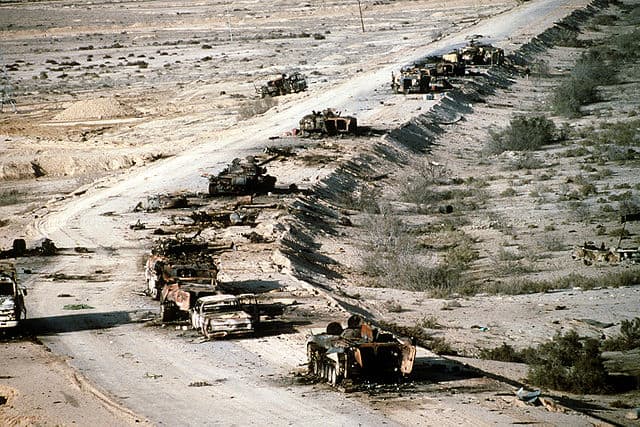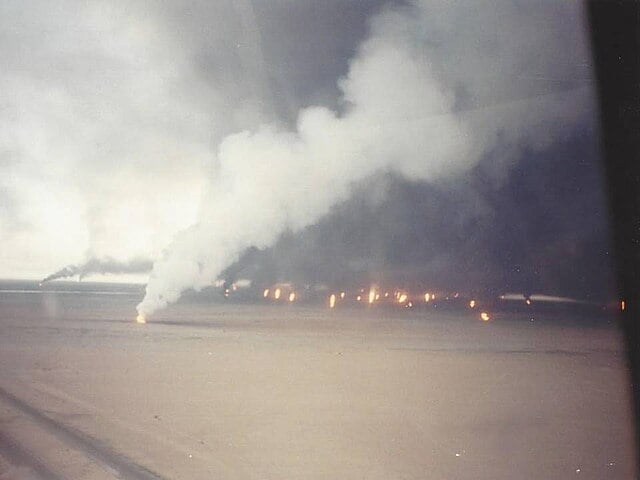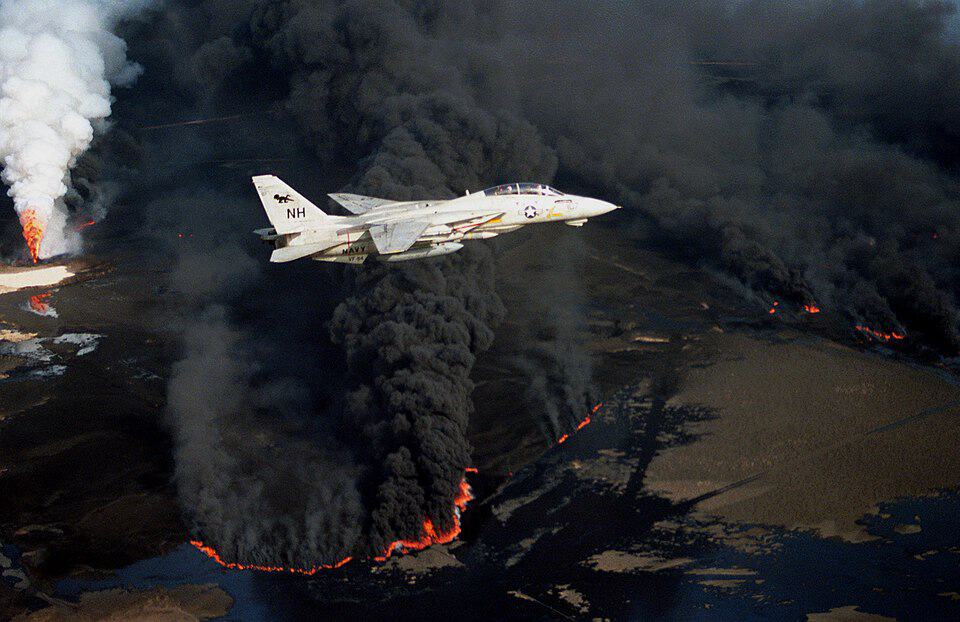
A 2010 Time Magazine article rated it as the third worst environmental catastrophe in history, right behind Chernobyl and Bhopal. As Operation Desert Storm drew to a close, with Kuwait liberated and the Iraqi Army all but destroyed, Saddam Hussein would not concede defeat. Like a cornered rat, he inflicted one more blow on Kuwait’s ecology and its oil production infrastructure, something he hoped would take years to recover from. So he ordered his men to blow up Kuwait’s oil wells. Some 700 were set on fire, unleashing a 20th Century Black Death.
Trying to extinguish the fires was a near impossibility at first. It was too dangerous to send in firefighting crews during the war and later it was discovered that land mines had been placed in the areas around the wells, meaning they had to be removed before the fires could be put out. Around 5 million barrels of oil were lost each day. Eventually, privately contracted crews extinguished the fires, at a total cost of $1.5 billion to Kuwait. About 90% of fires were put out with nothing but seawater: damaged oil pipelines were repaired and the flow was reversed to pump Persian Gulf seawater back to the burning oil wells.
Although the crews were able to finish the job much faster than anyone had imagined, the fires burned for ten months, causing widespread environmental devastation. NASA wrote, that “the sand and gravel on the land’s surface combined with oil and soot to form a layer of hardened ‘tarcrete’ over almost 5 percent of the country’s area.” Scores of livestock and other animals died from the oily mist, their lungs blackened by the liquid.
As Assistant Secretary of Near Eastern Affairs from 1989-1991, John Kelly saw firsthand the environmental devastation wrought by the retreating Iraqi Army in Kuwait, and the unearthly smoke and flames produced by the burning wells.Peter Galbraith served as a staff member on the Senate Foreign Relations Committee for 15 years, from 1978-1993; during his time on the staff he was heavily involved during the aftermath of the Gulf War.
While working as an Economic Officer specializing in Energy affairs in London, Paul Tyson was involved in coordinating the firefighting efforts in Kuwait. Eleanore Raven-Hamilton served in the Bureau of Oceans, Environment and Science at the State Department from 1990-1993, during which time she organized and coordinated American efforts to find solutions to the environmental problems caused by the release of millions of gallons of oil into the Persian Gulf.
Galbraith and Tyson were interviewed by Charles Stuart Kennedy beginning in March 1999 and July 2001, respectively. Raven-Hamilton was interviewed by Edward Dillery beginning in November 2009.
Read other Moments on Iraq.
“It was a scene out of Dante’s Inferno”
John Kelly, Assistant Secretary, Near Eastern Affairs, 1989-1991

KELLY: Saddam had managed to change the environment; fortunately, his damage was reversible. His actions were environmental war. Not only did he cover Kuwait and much of the Arab states with that black soot, but he also opened the oil pipeline sluices which flooded the Gulf itself with oil slicks, severely damaging all animal life in its path and endangering Saudi’s water intake plants further south. He created an environmental catastrophe in the Gulf area….
Our pilot flew at low level over much of Kuwait so that we could get a good close look at about 700 wells which were already up in flames. It was a scene out of Dante’s Inferno. We had some feeling for what we might see because the rain in Riyadh was already black. We had encountered a light shower before taking off to Kuwait and that was black water.
In Damascus — 800 miles away — the rain was black as it was in Tehran. The atmosphere had been thoroughly polluted. So we had some inkling of what we might see, but it was far worse than I expected.
Fifty miles away from the oil fields you could see a huge, black cloud hanging over the area. In fact, it wasn’t a solid cloud; we could fly over the oil fields picking our way through the clouds. As we crossed the Kuwait border, we could see the huge ditch that the Iraqis had dug — for hundreds of miles across the desert.
As we approached the fields, even through the thick smoke, you could see the huge tongues of fires burning out of the wells. The starkness of that image became even clearer as we flew between clouds and could see the ground clearly. It looked like the earth had opened up and volcanoes had sprung up everywhere. It was incredible; I have never seen nor hope to see again such horror.
We flew over the wells for a while and then the pilot took us of the so called “Highway of Death” which led north from Kuwait into Iraq. Our planes had decimated hundreds of vehicles which laid scattered on the road, in the ditches, in the desert. That was also an unforgettable sight.

We then landed in Kuwait City in what appeared dusk, although it was mid-day and the sun shone brightly above this black layer of smoke. This was March 1991. The temperature in Riyadh had been in the 90s; in Kuwait City it was in the 50s. The oil clouds were so thick that the sun could not shine through them.
The airport itself was almost entirely decimated; the city itself was jammed with inoperable tanks and vehicles, most of them having been shot by the Coalition air forces. There were still some fires smoldering here and there even though this a week after the Iraqis had fled.
We spent the rest of the day in Kuwait City. Our clothes rapidly became covered with the soot that was falling from the sky. Our hair became matted with the stuff. The things we touched felt oily….
On one of our subsequent visits to Kuwait, we went out and watched the Red Adair crews extinguish an oil well fire. That was a sight! The noise of oil burning is unbelievable from the pressure of the oil geysers and the roar of the flames. The ground was littered with little white flags marking the location of land mines.
We watched the Texas crew maneuvering a bulldozer covered with a heat shield; they sprayed heavy doses of water on the fires and on the vehicle so that they could continue to use it. The driver of the bulldozer used a mechanical arm to maneuver a pipe on top of the flames forcing them to rise higher into the atmosphere in a column of red. Then they would plug the pipe and thereby extinguish the fire.
The one they chose for us was a relatively easy one, but they told us that no one had ever had to extinguish 700 oil wells in the same area; the most they had ever done were three or four at one time. They used the Kuwait challenge to perfect their techniques; once they had done that, they did three or four wells each day. I think it only took them six months to do all 700 of them, which was a real feat.
“We got a lot of stuff done, and frankly didn’t ask Washington in many instances”
Paul Tyson, Economic Officer (Energy), Embassy London, 1989-1993
TYSON: I ended up doing an awful lot after the liberation. For some reason or another, my phone and my fax, or the fax in the econ section, became the contact point and we were dealing with what we called the “purple death ray people,” and that would be, you know, someone calls up and says, “I have a purple death ray that can solve the fire fighting. If you give me a million dollars (or whatever), this will go on.”
We toasted about four fax machines just overloaded with stuff coming in; engineering drawings and everything else. But it was an interesting process, once again involving Bechtel and Kuwait Petroleum. It was the type of thing that everybody was rushing to get into Kuwait and there was no particular reason for me to go there. There were problems getting equipment in and at one point Kuwait Petroleum came and basically asked to charter a C-5A in order to bring in a whole work over rig from Houston, which I helped arrange. It was one of the more bizarre moments of “go and rent an Air Force plane.”….

First of all, a lot of it was experience. On the fire-fighting in the past, what had happened is that basically it came down to the difference between a one-off construction or making a custom-made suit versus an assembly line. This was one of the few situations in the world. There was something in, I think ’47, in Borneo or whatever, where there was a field on fire, but most of the time fire-fighting involved one, perhaps two, wells going out.
Red Adair or Boots and Coots or one of the well-known people comes out, handles it, and it’s very specific to that.
In Kuwait you had close to 500 wells on fire and a number of them gushing oil, but not on fire. There were different problems. There were the ones gushing, but not on fire, the ones on fire, and then a subset of that, about 60 of them, were extremely high pressure with hydrogen sulfide, and extremely dangerous. So there was a basic effort to first get water pumped in, and then gradually an assembly line sort of development to handle the well-killing and the fire-fighting.
And it went along surprisingly fast. There had been predictions that it might take as long as five years and ultimately is was done in somewhere between nine and ten months. As it went on, there were a whole lot of different groups wanting to get involved in it – the Hungarians and others, and some of them were very good at it. The Kuwaitis had a lot of their own indigenous engineers involved in this, including one woman.
So with the support of Bechtel and a number of other things, Red Adair, Boots and Coots, and the firefighters — I think there were four groups, the firefighters specifically, it went remarkably well. A lot of it was cutting red tape; getting stuff to move and doing things like that. I don’t think there was any one real set decision-making process; there was an awful lot of autonomy and by working and coordinating with the Kuwaitis we just got a lot of stuff done, and frankly didn’t ask Washington in many instances.
“This was something I knew absolutely nothing about, so I would not interfere with them on technical issues”
Eleanore Raven-Hamilton, Bureau of Oceans, Environment and Science, State Department, 1990-1993
RAVEN: When I returned to Washington from New Caledonia, the Gulf War was winding down, and Saddam Hussein had set the oil fields in Kuwait on fire. I became involved in efforts to extinguish the oil fires. Ideas, some exotic, about putting out the fires, were pouring into the State Department and to the technical agencies. We had all sorts of well-known experts in the oil fire business offering help.
I was the State Department’s liaison on the multiagency task force, which was operating in a UN framework. All the agencies that had interests in issues created by the fires, including how to extinguish them and assess damage, were on the task force. The other agencies on the task force were technical agencies and, to some extent, rivals for leadership. They decided that the only agency that had “no dog in the fight” was the State Department. We just wanted to put out the fires, no matter how it was done, or by whom.
State focused on working with the international community, especially with countries in the region, whose cooperation and clearances would be needed for the work that had to be done. So, my colleagues from the other U.S. agencies told me I was in charge and would chair all the meetings. We all got along well and worked very well together, perhaps because my colleagues quickly realized that this was something I knew absolutely nothing about, so I would not interfere with them on technical issues. I would not have done that anyway.
Obviously, I learned a lot. My colleagues were very patient with me. They made the technical decisions, and I made sure we observed the “niceties” required for U.S. operations in foreign countries. Initially, the technical agencies were creating models to predict damage from the smoke as it rose through the atmosphere — how high did it go and where, how much pollution was being created and what effect could the fires have on world heath.

I was quite startled to find out that even when the people creating the models went back to their models from a day or two earlier and entered data collected after that, they were often not getting the results that they had predicted. So, we were dealing with the limits of predictability at that time, which was challenging for the model makers.
Then, we had the oil companies, the well-known oil firefighters, scientists, and all sorts of experts, who had schemes they insisted would extinguish the fires quickly. Some were ready to rush in to implement their ideas.
We had a few instances of free-lance American experts in the oil fields close to Kuwait calling press conferences, without telling the American ambassador or the State Department or anyone else, about what they “intended” to do. These press conferences were unofficial, but they were “American,” so they were newsworthy. They created a certain amount of confusion — was this an official American undertaking?
I felt I was always pulling back American experts, who wanted to have a press conference to announce what Americans would do to extinguish the fires or help the wildlife being affected. Few of them had any experience in dealing with foreign policy, and why should they?
The scientists and technological experts had a different perspective from the foreign policy community. The scientists often tried to be very open and say exactly what they were thinking. We couldn’t be so open and frank because the reality was that these were sovereign countries. Americans could not arrive and announce what they were going to do to the oil fires that your government is trying, unsuccessfully, to extinguish. We will show you how to do it.
It was a good thing to have someone from State on the task force. Some of our experts were doing their own thing, as if they were in the U.S. We also had public relations problems with some American environmental groups.
One environmental group had extensive TV coverage of oil covered birds, possibly the same bird, but it was still a pathetic sight. Photos of damaged birds were all over television. There was a lot of controversy over how to save oil covered birds and great enthusiasm for washing the oil off the birds. People felt good about washing birds, but I learned that this does not save them, if they are really covered with oil. The birds almost always die, as scientists had found out from earlier oil spills….It just doesn’t work, but people were trying to race out to save the birds. I was always writing press statements about the birds and what could be done to save them. Almost nothing if they were covered with oil.
I want to say that scientists and our technical agencies were really doing a tremendous job on this. They were rationally — and scientifically — dealing with this horrific act of deliberate destruction. Although exotic fire-fighting strategies were proposed, we learned that the very best way to put out the fires was to pour water on them. Of course, the fires were burning in the desert, so the biggest problem was how to get enough water to put on the fires.
“I wondered why this was the one time the U.S. Army Corps of Engineers had decided to come in under the estimate”
Peter Galbraith, Staff, Senate Foreign Relations Committee, 1978-1993

GALBRAITH: I remember walking across this scarred, fire-scarred earth and there was a part of a human skull, not much left of it, a small chunk of skull and other very burned bones. Some unlucky person who had been there when the bombs had set off the fire.
There were also wandering around starving horses and it was a very bleak landscape. We saw Red Adair’s team….Texas oil fire fighter. They were trying to cap the first of the several hundred wells that were either ignited or spouting oil. This was not a fire, but simply one that was spewing oil at very high pressure.
It was thought it was going to take years to put out all these oil field fires. In fact they did it in several months so the damage ended up being a lot less than it was feared it would be.
It was quite amazing. Everything was oil splattered. All the vehicles got oil splattered. Driving back I stopped and took a picture of a road sign that was pitch black. It was in the middle of a sunny day, but these oil fires were just so intense it made it look like night. Of course, unlike night where headlights can penetrate, in this nightmare headlights couldn’t penetrate….
In the end it was thought that it would be $100 billion to repair. Then U.S. Army Corps of Engineers came in and did these repairs and I think the final bill turned out to be under $10 billion.
Of course as an American, I’m interested in business. I wondered why this was the one time the U.S. Army Corps of Engineers had decided to come in under the estimate.
